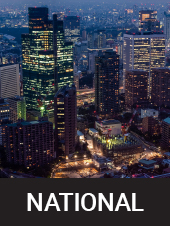As a heat wave grips parts of Ontario amid a scorching summer, some Canadian cities have been trying new techniques to try to tackle extreme heat, which can quickly turn deadly.
A Statistics Canada study last year showed there were roughly 670 deaths between 2000 and 2020 attributable to extreme heat events in 12 Canadian cities.
In 2021, a heat dome in British Columbia killed an estimated 619 people in one week.
And this week, temperatures in parts of Ontario are set to feel like the mid-40s C — and cities can feel the heat keenly due to how they’re built, experts say.
“The surfaces in the cities are such that they absorb more heat and that causes the entire environment to become hotter and the temperature rises as well,” said Sandeep Agrawal, a professor at the University of Alberta’s School of Urban and Regional Planning.
It’s due to the “urban heat island effect,” which can make a city one to three degrees hotter than the surrounding area during the day and warmer at night, according to decades of urban studies.
Among the reasons are glassy or concrete skyscrapers that absorb a lot of heat during the day and take longer to cool down at night.
James Voogt, a Western University professor of geography and environment, said heat is a top “weather hazard.”
“Our ability to physiologically respond to those is relatively slow,” he said.
From increasing tree cover to installing “green” roofs, here’s how some Canadian cities have been trying new techniques to try to tackle extreme heat.
A study by the European Commission in 2023 found that increasing tree coverage to 30 per cent in European cities could lower temperatures by an average 0.4 C, with a maximum effect of 5.9 C in some areas, avoiding 2,644 premature deaths.
Planting more trees is one approach some Canadian cities are using.

Get daily National news
Get the day’s top news, political, economic, and current affairs headlines, delivered to your inbox once a day.
Toronto plans to increase the number of trees covering streets to 40 per cent canopy cover by 2050 by planting about 120,000 trees a year.
“So you want to make use of strategic planting of trees to try to take advantage of the fact that a tree cools by shading a surface and a tree cools by evapo-transpiring water,” Voogt said.
“So if you strategically locate your tree well, you can get maximum benefit.”
In May, Vancouver approved an update to its urban forest strategy with a goal of covering 30 per cent of the city with tree canopy by 2050.
Trees take time to grow, but they can still benefit cities in the long term, said Sara Barron, program director for the Master of Urban Forestry Leadership Program at the University of British Columbia.
“That immediate impact, it’s not going to help maybe with next year’s heat wave, but we know climate change is a shift that’s going to be happening for years,” she said.
Voogt cautioned that it may be difficult to just dig up areas of downtown Toronto to plant trees, but green roofs are an alternative.
The Urban Land Institute said green roofs replace dark surfaces with soil and vegetation, noting that the “greening” of five per cent of Toronto’s area lowered citywide temperatures by an estimated 1.5 to two degrees.
Toronto implemented a green roof bylaw in 2009, requiring new commercial and industrial developments of more than 2,000 square metres to incorporate them.
Other cities have also taken steps, including Saskatoon, which offers a stormwater credit for commercial buildings with green roofs, and Port Coquitlam, B.C., which fast-tracks development applications that incorporate green roofs.
There are also other techniques cities are using outside of Canada.
The Spanish city of Murcia implemented 61 measures to adapt to extreme heat, including resurfacing dark asphalt roads with lighter-coloured materials to reflect sunlight, with Dallas doing something similar by installing reflective pavement.
The Texas city has also required new buildings to use materials that reflect solar heat on at least 75 per cent of the surface or have 50 per cent of the roof covered by vegetation.
While some cities have taken steps, Agrawal said “better design” is needed.
“So incorporating more vegetation, vegetation cover and tree canopies, (and) permeable material within the built environment I think would lead to a more sort of sustainable and cooler environment than the current way of doing it, where it’s sort of a patchwork of things being done,” Agrawal said.
Barron noted changes like using lighter material for roads to lower heat absorption and adding water where you can, such as water fountains, can make a difference.
Using misting systems can also help with cooling, which she said has been used in places like Australia. The systems are set up to spray a mist of water around an area, or to let people walk through them to cool down.
Voogt said city planning can also improve how it handles heat, though he said that is a longer-term solution.
“So changing the form of the city, the way it’s laid out, how the buildings are spaced, that’s longer term, right, because you don’t change the buildings that often,” he said.
“What we have to do is start thinking about cities that are a little bit more optimized in terms of the climate they’re embedded in.”








